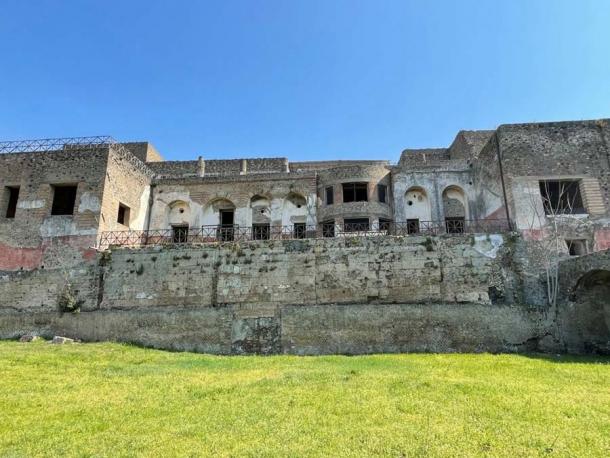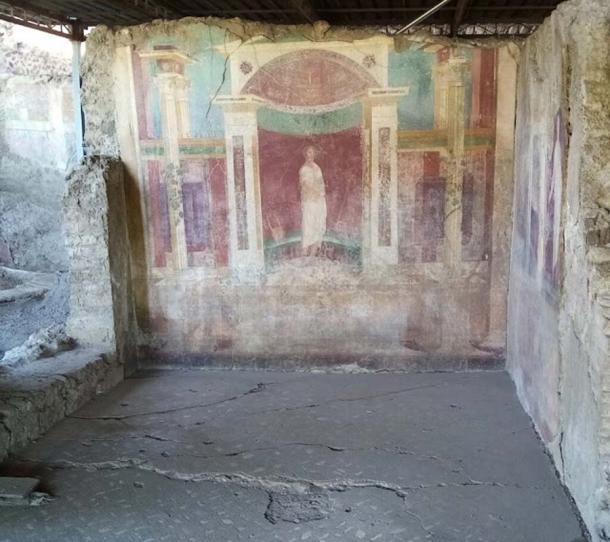Evidence of Fresco Painting Uncovered at Library House in Pompeii
Recent restoration work in ancient Pompeii has uncovered evidence that work was being carried out at the Library House, or Casa della Biblioteca, when Mount Vesuvius erupted in 79 AD, reports Archaeology News Network. First excavated as early as in the 18th century and then again in the 1970s, this Library House in Pompeii was given its name after one of its interior rooms was identified as a library by the German scholar Volker Michael Strocka.

Renovation work, to stabilize the urban villa complex known as the Insula Occidentalis, has allowed archaeologists to unearth previously undiscovered artifacts at the Library House in Pompeii. (Pompeii - Parco Archeologico)
Putting the Library House into Context: Ancient Pompeii and its Gruesome End
Offering a panoramic view of the Gulf of Naples, the ancient city of Pompeii, was an enclave where rich Romans built luxurious villas with lavish decorations, furnishings and works of art. Today it is a UNESCO World Heritage Site. Pompeii and its surrounding area became very prosperous owing both to the rich agricultural land and its proximity to the Gulf of Naples.
So much so that many farms and villas were built nearby, outside the city. Many have now been excavated. The most exclusive address in ancient Pompeii, however, was the Insula Occidentalis, an urban villa complex divided between the 6th and 7th regiones.
Located on the western edge of Pompeii, it gives a breathtaking sight of the gulf and became home to the ville urbane (urban villas) from the second century BC. These were located above the city walls and had terraces that opened out onto the vista.
- Horrific Slave Room Discovered in Pompeii’s Civita Giuliana
- Spectacular 2000-Year-Old Pompeii Food Stall Reopens for Business!
It was in 89 BC that Pompeii became the Roman colony of Colonia Cornelia Veneria Pompeianorum under the Roman general Sulla. After its annexation, the villas grew in size and added a series of terraces sloping right down to the sea.
All this prosperity and leisure came to an abrupt end in 79 AD when a massive volcanic eruption of Mount Vesuvius covered the city and its surroundings in volcanic ash and pumice. Its ash covering acting to preserve it well, the discovery of the ancient city in modern times gave a fascinating insight into Roman life in the first century AD, frozen in the moment.

One of the Library House frescoes in Pompeii. (Pompeii Archaeological Park)
The House of the Library and Its Marvels
Early excavations by the Bourbons in the 18th century, followed by later ones in the 1970s, brought to light many of the urban villas with their beautiful frescoes. In recent months, work has been ongoing to restore Pompeii’s Insula Occidentalis and, in particular, the House of the Library, the House of the Golden Bracelet, the House of Fabius Rufus and the House of Castricio.
The House of the Library, located on Vicolo del Pharmacista, south of its junction with Via Consolare, is perhaps most representative of the leisure and meditative pursuits of the occupants of the urban villas. And it is from here that new finds have been unearthed including of life in the last moments before volcanic ash extinguished it.
The entrance to the Library House Pompeii, located to the west of the Vicolo del Pharmacista, opens directly into the atrium with tetrastil (four columns) around the central imluvium pool. The atrium is in a poor condition, and the walls have mostly fallen. Only a few broken columns testify to its former grandeur.
However, on the eastern wall of the House of the Library, on both sides of the entrance and in the south, vestiges of wall frescoes can be seen. The frescoes are made up of dark red panels framed with white lines on a pastel green background above a low frieze, Ermakvagus.com states.
From the south-east corner of the atrium, a large room opens. Once again, it is in ruins. The fresco remnants here largely consist of painted columns on a predominantly red background above a high frieze in yellow and red. The bedroom in the northwest corner of the atrium is decorated with clearer red rectangles on a yellow background.
#NewDiscovery at the House of the Library in the Insula Occidentalis of #Pompeii, providing new evidence on the works being carried out on this house when Mount Vesuvius erupted in 79 AD. For more info @pompeii_sites pic.twitter.com/7c0SdUDeMc
— Rubén Montoya (@rubsmontoya) December 9, 2021
Exploring the Interior of the Library House in Pompeii
The so-called “library” room still has a spectacular fresco showing a figure with an ivy-crowned head, carrying a scroll, a lyre and a box for books. It has been tentatively identified as Philoxenus of Kythera who lived in the second half of the 5th century BC and composed in Greek.
A worked stone disc, a bronze or copper vase and an olla (jar) that have been discovered within the Library House in Pompeii all seem to have been used for fresco painting. The circular, polished stone disc still bears traces of fragments of glass paste ready for the milling necessary to produce Egyptian Blue, a blue pigment used for painting.
- The Lupanare: Prostitution and Houses of Pleasure in Ancient Pompeii
- Roman Secret Society Lodge Discovered in Pompeii
The copper vase contains a small iron crucible that was probably used to heat the oxides in the pigment-production process. The olla was found opposite the threshold of the opening that connected a massive vaulted room with the terrace. Both finds are now undergoing content analysis.
An ancient city agonizingly frozen in time, Pompeii is one of Italy’s largest tourist attractions. Although many of the striking wall frescoes decorating its villas are now housed in museums, there are several fragments still found adorning the ruined walls. The latest discoveries from the House of the Library offer an insight into some of the processes that went into their painting.
Top image: Artifacts unearthed during excavations at the Library House in Pompeii point to work being done painting frescos at the time of the volcanic eruption. Source: Pompeii Archaeological Park
By Sahir Pandey




















Comments
More pictures and details from the wonderful website:
https://sites.google.com/site/ad79eruption/pompeii/regio-vi/reg-vi-ins-17/house-of-the-library
You can also do Google streetview for a lot of Pompeii and Herculaneum.